Abstract
Simian acquired immunodeficiency syndrome is a fatal immunosuppressive disease caused by type D retroviruses such as simian acquired immunodeficiency syndrome retrovirus type 1 (SRV-1). The disease is characterized by generalized lymphadenopathy, opportunistic infections, and lymphoid depletion with defects in both humoral and cell-mediated immunity. To understand how SRV-1 infection relates to the immune defect, we studied in vivo-infected lymphocytes from SRV-1-positive macaques with and without clinical signs of immunosuppressive disease. B and T helper/inducer and T suppressor/cytotoxic lymphocytes were purified by panning or by flow cytometry. Neutrophils were purified by dextran sedimentation, and platelets were purified by low-speed centrifugation. In vitro infection studies were also done with HUT78, H9, K562, rhesus lung fibroblast, rhesus monkey kidney, and bat lung cells. SRV-1 in lymphocytes or culture supernatants was detected by the induction of syncytia in cocultivated Raji cells and was confirmed by immunofluorescence, electron microscopy, or reverse transcriptase assay. We found that B and T helper/inducer lymphocytes were infected in all animals tested. The number of infected T suppressor/cytotoxic cells was generally lower than that of the other cell subsets, and not all animals in this subset had SRV-1 infections. All other cells exposed in vitro to SRV-1, except bat lung cells, were able to be infected. These findings show that SRV-1 has a broad cell tropism for lymphoid and nonlymphoid cell types.
Full text
PDF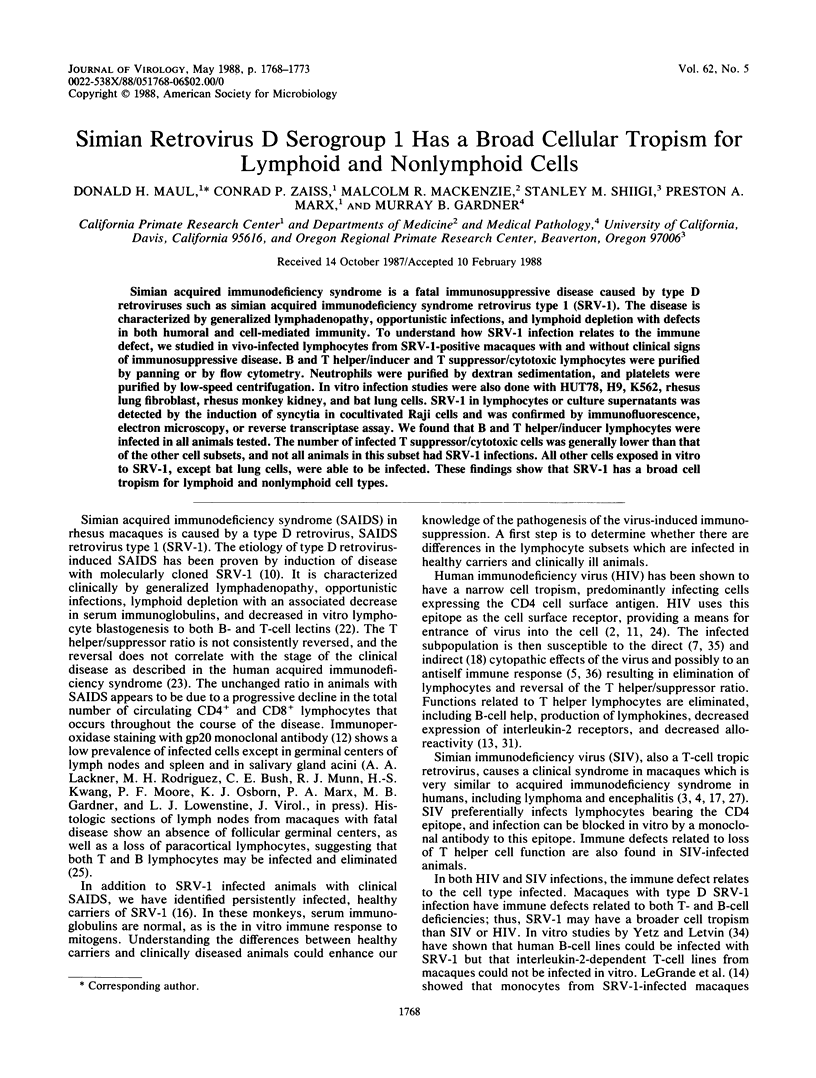
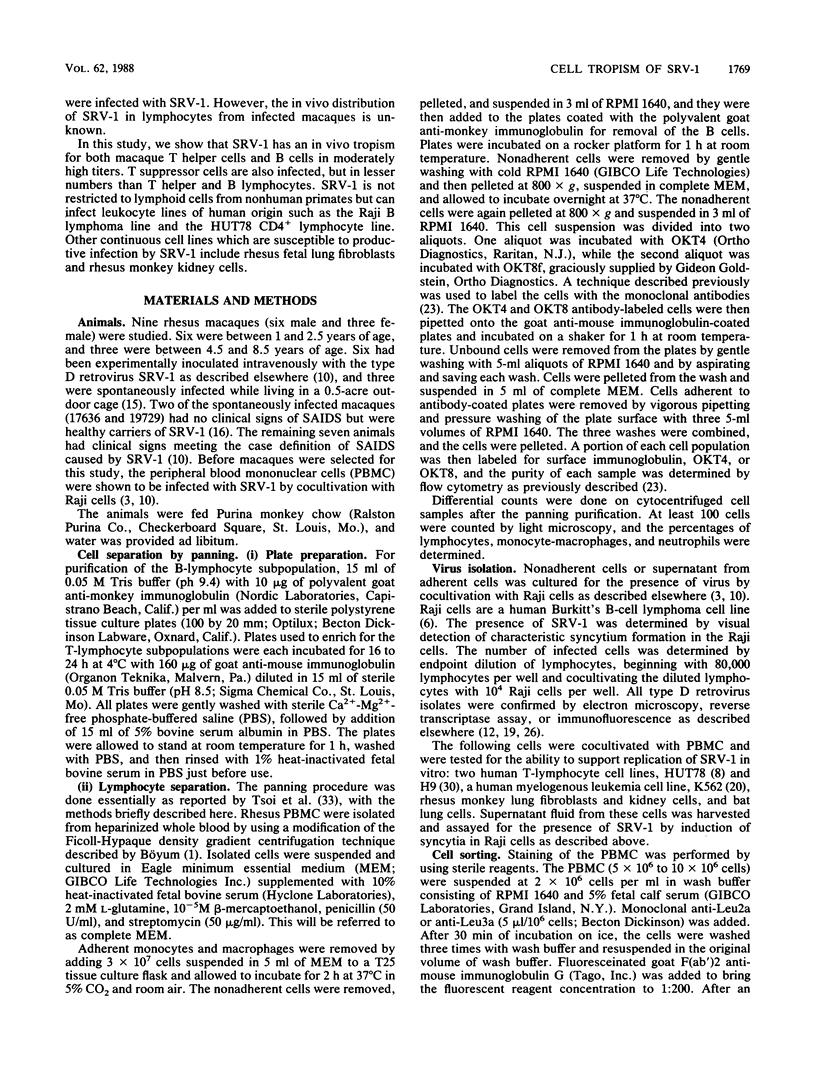
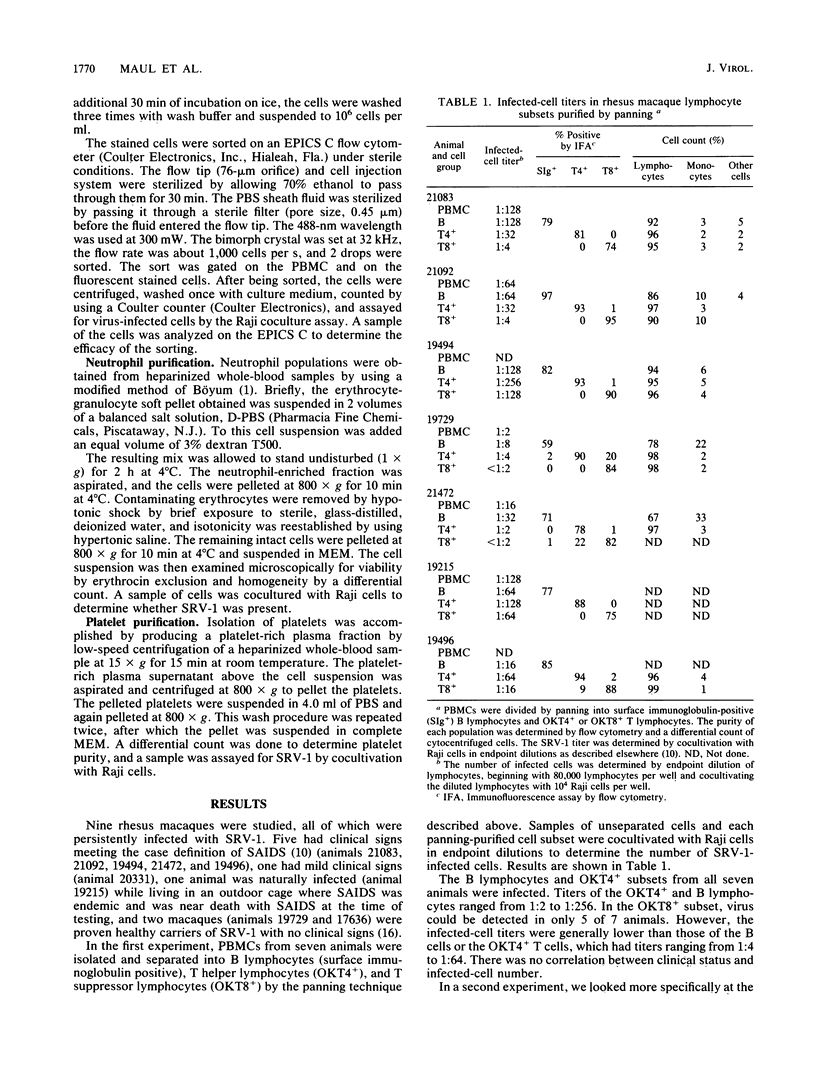
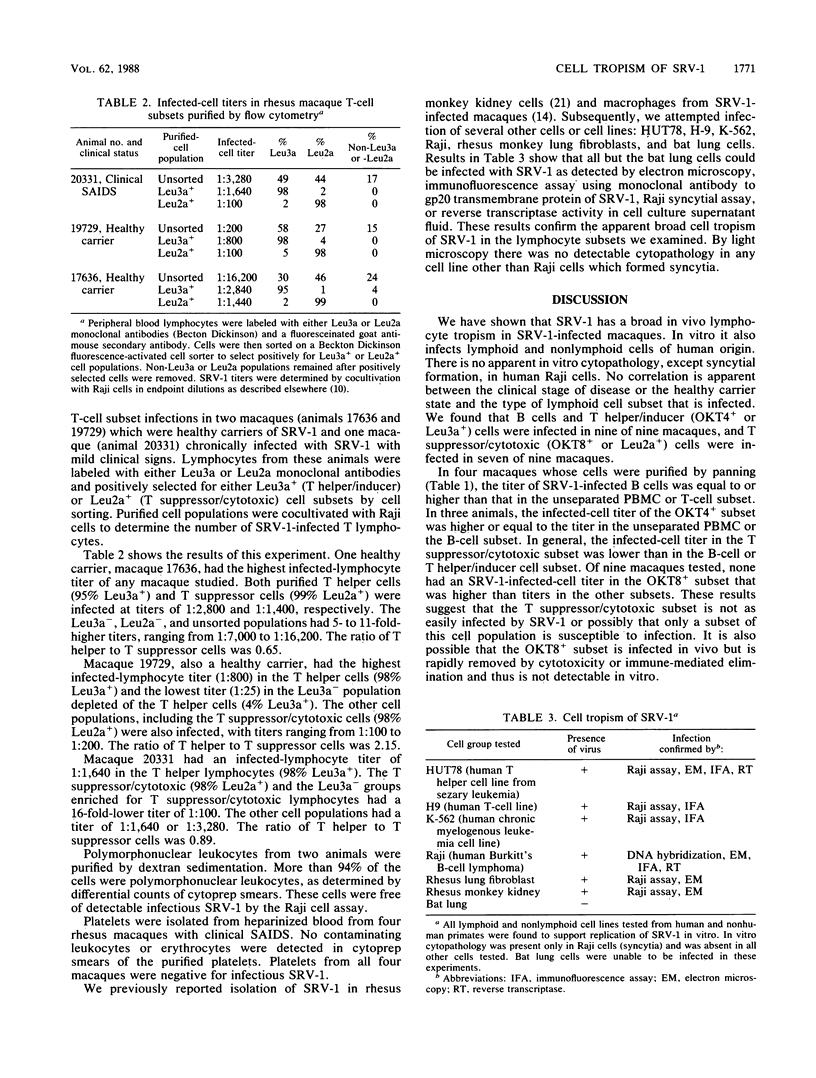
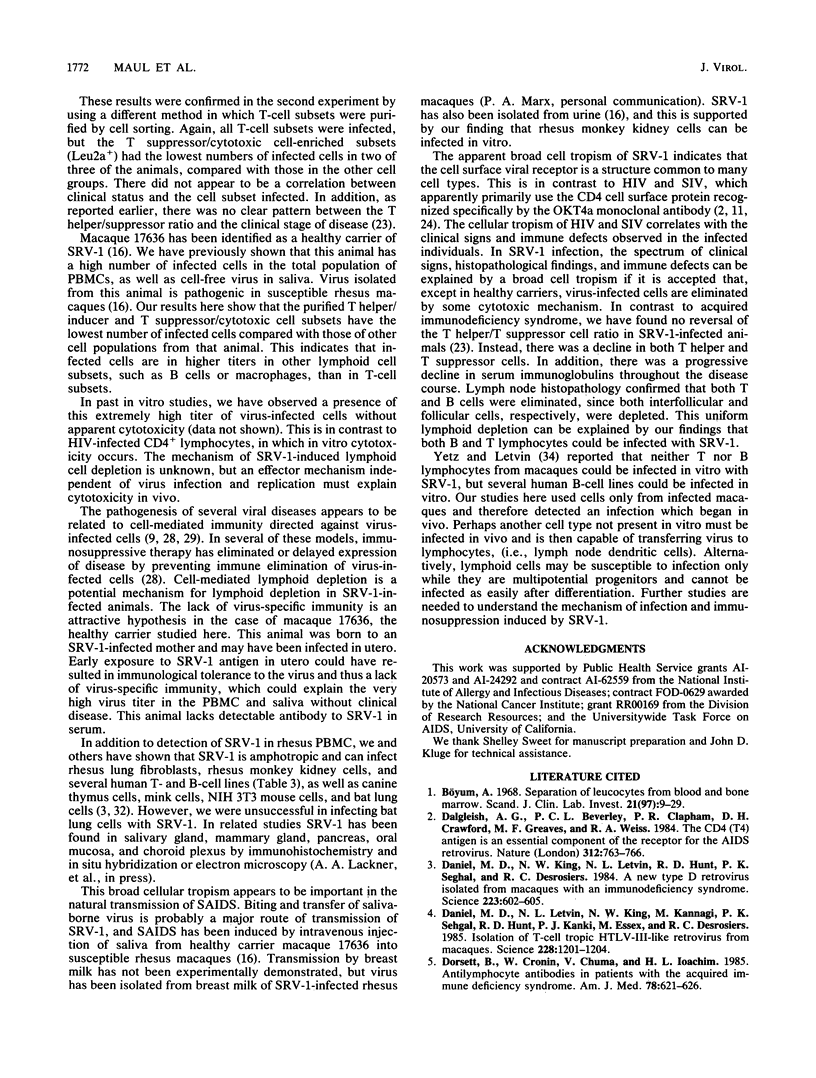
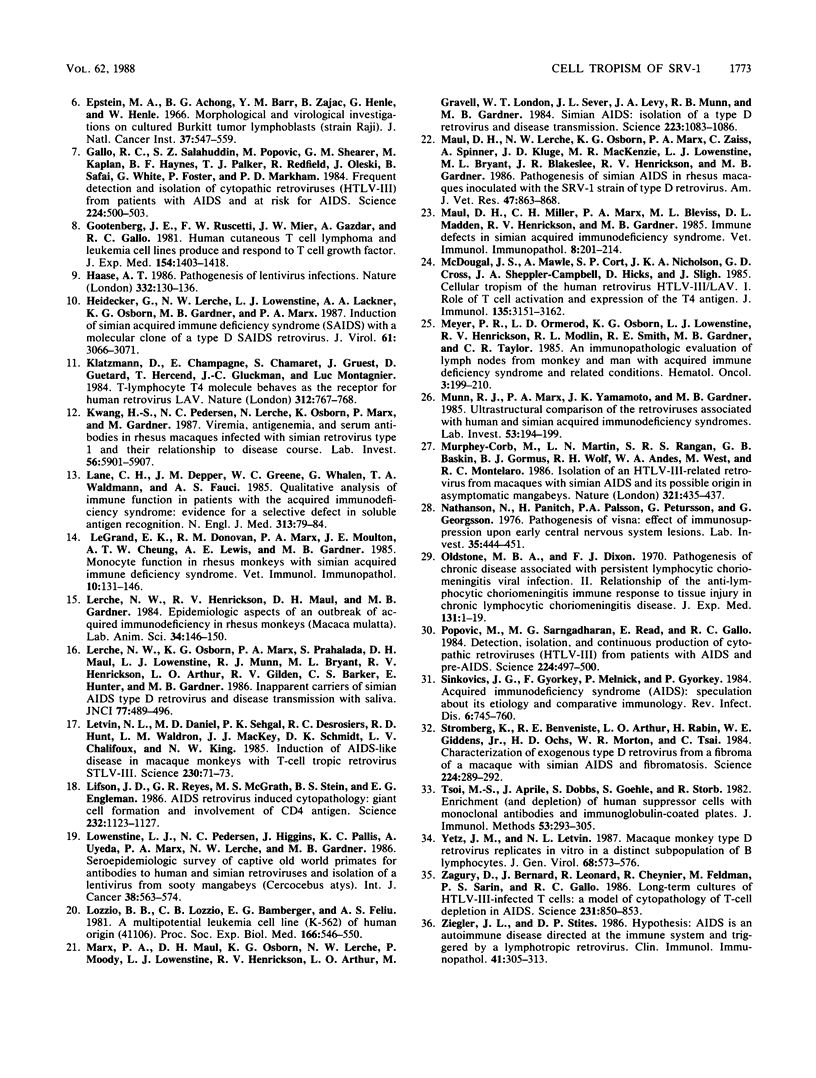
Selected References
These references are in PubMed. This may not be the complete list of references from this article.
- Böyum A. Isolation of leucocytes from human blood. A two-phase system for removal of red cells with methylcellulose as erythrocyte-aggregating agent. Scand J Clin Lab Invest Suppl. 1968;97:9–29. [PubMed] [Google Scholar]
- Dalgleish A. G., Beverley P. C., Clapham P. R., Crawford D. H., Greaves M. F., Weiss R. A. The CD4 (T4) antigen is an essential component of the receptor for the AIDS retrovirus. Nature. 1984 Dec 20;312(5996):763–767. doi: 10.1038/312763a0. [DOI] [PubMed] [Google Scholar]
- Daniel M. D., King N. W., Letvin N. L., Hunt R. D., Sehgal P. K., Desrosiers R. C. A new type D retrovirus isolated from macaques with an immunodeficiency syndrome. Science. 1984 Feb 10;223(4636):602–605. doi: 10.1126/science.6695172. [DOI] [PubMed] [Google Scholar]
- Daniel M. D., Letvin N. L., King N. W., Kannagi M., Sehgal P. K., Hunt R. D., Kanki P. J., Essex M., Desrosiers R. C. Isolation of T-cell tropic HTLV-III-like retrovirus from macaques. Science. 1985 Jun 7;228(4704):1201–1204. doi: 10.1126/science.3159089. [DOI] [PubMed] [Google Scholar]
- Dorsett B., Cronin W., Chuma V., Ioachim H. L. Anti-lymphocyte antibodies in patients with the acquired immune deficiency syndrome. Am J Med. 1985 Apr;78(4):621–626. doi: 10.1016/0002-9343(85)90405-x. [DOI] [PubMed] [Google Scholar]
- Epstein M. A., Achong B. G., Barr Y. M., Zajac B., Henle G., Henle W. Morphological and virological investigations on cultured Burkitt tumor lymphoblasts (strain Raji). J Natl Cancer Inst. 1966 Oct;37(4):547–559. [PubMed] [Google Scholar]
- Gallo R. C., Salahuddin S. Z., Popovic M., Shearer G. M., Kaplan M., Haynes B. F., Palker T. J., Redfield R., Oleske J., Safai B. Frequent detection and isolation of cytopathic retroviruses (HTLV-III) from patients with AIDS and at risk for AIDS. Science. 1984 May 4;224(4648):500–503. doi: 10.1126/science.6200936. [DOI] [PubMed] [Google Scholar]
- Gootenberg J. E., Ruscetti F. W., Mier J. W., Gazdar A., Gallo R. C. Human cutaneous T cell lymphoma and leukemia cell lines produce and respond to T cell growth factor. J Exp Med. 1981 Nov 1;154(5):1403–1418. doi: 10.1084/jem.154.5.1403. [DOI] [PMC free article] [PubMed] [Google Scholar]
- Haase A. T. Pathogenesis of lentivirus infections. Nature. 1986 Jul 10;322(6075):130–136. doi: 10.1038/322130a0. [DOI] [PubMed] [Google Scholar]
- Heidecker G., Lerche N. W., Lowenstine L. J., Lackner A. A., Osborn K. G., Gardner M. B., Marx P. A. Induction of simian acquired immune deficiency syndrome (SAIDS) with a molecular clone of a type D SAIDS retrovirus. J Virol. 1987 Oct;61(10):3066–3071. doi: 10.1128/jvi.61.10.3066-3071.1987. [DOI] [PMC free article] [PubMed] [Google Scholar]
- Klatzmann D., Champagne E., Chamaret S., Gruest J., Guetard D., Hercend T., Gluckman J. C., Montagnier L. T-lymphocyte T4 molecule behaves as the receptor for human retrovirus LAV. Nature. 1984 Dec 20;312(5996):767–768. doi: 10.1038/312767a0. [DOI] [PubMed] [Google Scholar]
- Lane H. C., Depper J. M., Greene W. C., Whalen G., Waldmann T. A., Fauci A. S. Qualitative analysis of immune function in patients with the acquired immunodeficiency syndrome. Evidence for a selective defect in soluble antigen recognition. N Engl J Med. 1985 Jul 11;313(2):79–84. doi: 10.1056/NEJM198507113130204. [DOI] [PubMed] [Google Scholar]
- Legrand E. K., Donovan R. M., Marx P. A., Moulton J. E., Cheung A. T., Lewis A. E., Gardner M. B. Monocyte function in rhesus monkeys with simian acquired immune deficiency syndrome. Vet Immunol Immunopathol. 1985 Nov;10(2-3):131–146. doi: 10.1016/0165-2427(85)90041-8. [DOI] [PubMed] [Google Scholar]
- Lerche N. W., Henrickson R. V., Maul D. H., Gardner M. B. Epidemiologic aspects of an outbreak of acquired immunodeficiency in rhesus monkeys (Macaca mulatta). Lab Anim Sci. 1984 Apr;34(2):146–150. [PubMed] [Google Scholar]
- Lerche N. W., Osborn K. G., Marx P. A., Prahalada S., Maul D. H., Lowenstine L. J., Munn R. J., Bryant M. L., Henrickson R. V., Arthur L. O. Inapparent carriers of simian acquired immune deficiency syndrome type D retrovirus and disease transmission with saliva. J Natl Cancer Inst. 1986 Aug;77(2):489–496. [PubMed] [Google Scholar]
- Letvin N. L., Daniel M. D., Sehgal P. K., Desrosiers R. C., Hunt R. D., Waldron L. M., MacKey J. J., Schmidt D. K., Chalifoux L. V., King N. W. Induction of AIDS-like disease in macaque monkeys with T-cell tropic retrovirus STLV-III. Science. 1985 Oct 4;230(4721):71–73. doi: 10.1126/science.2412295. [DOI] [PubMed] [Google Scholar]
- Lifson J. D., Reyes G. R., McGrath M. S., Stein B. S., Engleman E. G. AIDS retrovirus induced cytopathology: giant cell formation and involvement of CD4 antigen. Science. 1986 May 30;232(4754):1123–1127. doi: 10.1126/science.3010463. [DOI] [PubMed] [Google Scholar]
- Lowenstine L. J., Pedersen N. C., Higgins J., Pallis K. C., Uyeda A., Marx P., Lerche N. W., Munn R. J., Gardner M. B. Seroepidemiologic survey of captive Old-World primates for antibodies to human and simian retroviruses, and isolation of a lentivirus from sooty mangabeys (Cercocebus atys). Int J Cancer. 1986 Oct 15;38(4):563–574. doi: 10.1002/ijc.2910380417. [DOI] [PubMed] [Google Scholar]
- Lozzio B. B., Lozzio C. B., Bamberger E. G., Feliu A. S. A multipotential leukemia cell line (K-562) of human origin. Proc Soc Exp Biol Med. 1981 Apr;166(4):546–550. doi: 10.3181/00379727-166-41106. [DOI] [PubMed] [Google Scholar]
- Marx P. A., Maul D. H., Osborn K. G., Lerche N. W., Moody P., Lowenstine L. J., Henrickson R. V., Arthur L. O., Gilden R. V., Gravell M. Simian AIDS: isolation of a type D retrovirus and transmission of the disease. Science. 1984 Mar 9;223(4640):1083–1086. doi: 10.1126/science.6695196. [DOI] [PubMed] [Google Scholar]
- Maul D. H., Lerche N. W., Osborn K. G., Marx P. A., Zaiss C., Spinner A., Kluge J. D., MacKenzie M. R., Lowenstine L. J., Bryant M. L. Pathogenesis of simian AIDS in rhesus macaques inoculated with the SRV-1 strain of type D retrovirus. Am J Vet Res. 1986 Apr;47(4):863–868. [PubMed] [Google Scholar]
- Maul D. H., Miller C. H., Marx P. A., Bleviss M. L., Madden D. L., Henrickson R. V., Gardner M. B. Immune defects in simian acquired immunodeficiency syndrome. Vet Immunol Immunopathol. 1985 Feb;8(3):201–214. doi: 10.1016/0165-2427(85)90081-9. [DOI] [PubMed] [Google Scholar]
- McDougal J. S., Mawle A., Cort S. P., Nicholson J. K., Cross G. D., Scheppler-Campbell J. A., Hicks D., Sligh J. Cellular tropism of the human retrovirus HTLV-III/LAV. I. Role of T cell activation and expression of the T4 antigen. J Immunol. 1985 Nov;135(5):3151–3162. [PubMed] [Google Scholar]
- Meyer P. R., Ormerod L. D., Osborn K. G., Lowenstine L. J., Hendrickson R. V., Modlin R. L., Smith R. E., Gardner M. B., Taylor C. R. An immunopathologic evaluation of lymph nodes from monkey and man with acquired immune deficiency syndrome and related conditions. Hematol Oncol. 1985 Jul-Sep;3(3):199–210. doi: 10.1002/hon.2900030308. [DOI] [PubMed] [Google Scholar]
- Munn R. J., Marx P. A., Yamamoto J. K., Gardner M. B. Ultrastructural comparison of the retroviruses associated with human and simian acquired immunodeficiency syndromes. Lab Invest. 1985 Aug;53(2):194–199. [PubMed] [Google Scholar]
- Murphey-Corb M., Martin L. N., Rangan S. R., Baskin G. B., Gormus B. J., Wolf R. H., Andes W. A., West M., Montelaro R. C. Isolation of an HTLV-III-related retrovirus from macaques with simian AIDS and its possible origin in asymptomatic mangabeys. Nature. 1986 May 22;321(6068):435–437. doi: 10.1038/321435a0. [DOI] [PubMed] [Google Scholar]
- Nathanson N., Panitch H., Palsson P. A., Petursson G., Georgsson G. Pathogenesis of visna. II. Effect of immunosuppression upon early central nervous system lesions. Lab Invest. 1976 Nov;35(5):444–451. [PubMed] [Google Scholar]
- Oldstone M. B., Dixon F. J. Pathogenesis of chronic disease associated with persistent lymphocytic choriomeningitis viral infection. II. Relationship of the anti-lymphocytic choriomeningitis immune response to tissue injury in chronic lymphocytic choriomeningitis disease. J Exp Med. 1970 Jan 1;131(1):1–19. doi: 10.1084/jem.131.1.1. [DOI] [PMC free article] [PubMed] [Google Scholar]
- Popovic M., Sarngadharan M. G., Read E., Gallo R. C. Detection, isolation, and continuous production of cytopathic retroviruses (HTLV-III) from patients with AIDS and pre-AIDS. Science. 1984 May 4;224(4648):497–500. doi: 10.1126/science.6200935. [DOI] [PubMed] [Google Scholar]
- Sinkovics J. G., Gyorkey F., Melnick J. L., Gyorkey P. Acquired immune deficiency syndrome (AIDS): speculations about its etiology and comparative immunology. Rev Infect Dis. 1984 Sep-Oct;6(5):745–760. doi: 10.1093/clinids/6.5.745. [DOI] [PubMed] [Google Scholar]
- Stromberg K., Benveniste R. E., Arthur L. O., Rabin H., Giddens W. E., Jr, Ochs H. D., Morton W. R., Tsai C. C. Characterization of exogenous type D retrovirus from a fibroma of a macaque with simian AIDS and fibromatosis. Science. 1984 Apr 20;224(4646):289–282. doi: 10.1126/science.6200929. [DOI] [PubMed] [Google Scholar]
- Tsoi M. S., Aprile J., Dobbs S., Goehle S., Storb R. Enrichment (and depletion) of human suppressor cells with monoclonal antibodies and immunoglobulin-coated plates. J Immunol Methods. 1982 Sep 30;53(3):293–305. doi: 10.1016/0022-1759(82)90176-4. [DOI] [PubMed] [Google Scholar]
- Yetz J. M., Letvin N. L. Macaque monkey type D retrovirus replicates in vitro in a distinct subpopulation of B lymphocytes. J Gen Virol. 1987 Feb;68(Pt 2):573–576. doi: 10.1099/0022-1317-68-2-573. [DOI] [PubMed] [Google Scholar]
- Zagury D., Bernard J., Leonard R., Cheynier R., Feldman M., Sarin P. S., Gallo R. C. Long-term cultures of HTLV-III--infected T cells: a model of cytopathology of T-cell depletion in AIDS. Science. 1986 Feb 21;231(4740):850–853. doi: 10.1126/science.2418502. [DOI] [PubMed] [Google Scholar]
- Ziegler J. L., Stites D. P. Hypothesis: AIDS is an autoimmune disease directed at the immune system and triggered by a lymphotropic retrovirus. Clin Immunol Immunopathol. 1986 Dec;41(3):305–313. doi: 10.1016/0090-1229(86)90001-2. [DOI] [PubMed] [Google Scholar]


